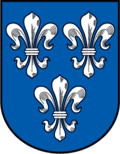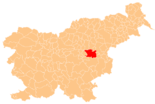Laško
| Laško | |||
|
|||
| Basic data | |||
|---|---|---|---|
| Country |
|
||
| Historic region | Lower Styria / Štajerska | ||
| Statistical region | Savinjska (Sann area) | ||
| Coordinates | 46 ° 9 ' N , 15 ° 14' E | ||
| surface | 197.5 km² | ||
| Residents | 13,730 (2002) | ||
| Population density | 70 inhabitants per km² | ||
| Post Code | 3270 | ||
| License Plate | CE | ||
| Structure and administration | |||
| Website | |||
Laško ( German : Tüffer , often also Markt Tüffer ) is a municipality in the Slovenian greater region of Štajerska .
Geographical location
The city lies in the valley of the Savinja on both sides of the river and on the former Austrian southern railway Vienna – Trieste.
Zidani Most (at the mouth of the Savinja River into the Save ) and Rimske Toplice also belong to the municipality of Laško .
Laško's neighboring town is Celje , which is located to the north and is larger .
history
The place was first mentioned in 1227. The beer brewery known for the place goes back to the year 1817. In 1847 Tüffer was connected to the railway network. In 1900 the then market town of Tüffer had 842 inhabitants. Of these, 485 were Germans and 334 Slovenes. In 1927 the place received city rights. Until 1945, the place and the surrounding area was one of several German-speaking islands in what is now Slovenia.
Mass grave at Huda Jama
At the end of February / beginning of March 2009 , a mass grave from May and June 1945 was discovered in the Barbara tunnel near the village of Huda Jama ( Bad Pit ), about five kilometers west of the center of Laško, from which several hundred mummified corpses have since been recovered were. In total, the responsible investigators estimate the number of those murdered at several thousand. Reports of witnesses According to it should the victims were remaining troops of the Croatian NDH - armed forces act and to Nazi collaborators from Slovenia who were murdered immediately after the end of World War II by the ruling communists.
Economy and tourism
The city is best known in Slovenia for its brewery , whose beer is one of the most popular in Slovenia. The thermal baths (32–35 °) in the community, which have been in use since 1852 ("Kaiser-Franz-Josephs-Bad"), are also steeped in tradition . From 1953 on, the thermal baths were used as an institute for medical rehabilitation, but in recent years the focus has been on tourism marketing as a health and wellness center. The district of Rimske Toplice also has a thermal bath.
Districts of the entire municipality
- Belovo (German Wellau )
- Blatni Vrh (German Plattenberg )
- Brezno (German Bresno near Wellau )
- Brodnice (German Brödnitz )
- Brstnik (German Werstnigg )
- Brstovnica (German Bristownitz )
- Bukovca (German Bukovza )
- Curnovec (German Zornsberg )
- Debro ( Eng . Obertüffer )
- Doblatina (German Toblatin )
- Dol pri Laškem (German: Thal )
- Gabrno (German Gabern )
- Globoko (German Globock )
- Govce (German Goldsberg )
- Gozdec (German Gosdetz )
- Gračnica (German Gratschnitz near Laakdorf )
- Harje ( Eng . Harje )
- Huda Jama ( German: Schlimme Grube , older Teufelsgraben )
- Jagoče (German Jagodic )
- Jurklošter ( German: Gairach )
- Kladje ( Engl . Kleidach )
- Klenovo (German Chlenau )
- Conc (dt. Kontz )
- Kuretno (dt. ' )
- Lahomno ( German: Lochomel , also Lochmel )
- Lahomšek (German Birkstein )
- Lahov Graben ( German: Graben bei Gairach )
- Laška vas (German forest village )
- Laško (German: Markt Tüffer )
- Laziše (German Lassach )
- Leskovca (German Haslach )
- Lipni Dol (German Lindenthal )
- Lokavec ( Eng . Lokautz near Laak )
- Lože ( Eng . Loschach bei Tüffern )
- Mačkovec (dt. Katzendorf )
- Mala Breza (German Niederbirk )
- Male Grahovše (German Little Grachusha )
- Marija Gradec ( German: Marienberg )
- Marijina vas ( German: Mariendorf )
- Modrič (German Mödritz )
- Mrzlo Polje (German Kaltenfeld )
- Obrežje pri Zidanem Mostu ( German: Sankt Peter bei Tüffer )
- Ojstro (German Easter )
- Olešče ( German: Sankt Peter bei Gairach )
- Padež (German Padesch )
- Paneče (German Panetz )
- Plazovje ( Eng . Plas )
- Polana (German Pollane near Gairach )
- Povčeno (German roach )
- Požnica (German Poschnitz )
- Radoblje (German Luterendorf )
- Reka (German Riecken )
- Rifengozd ( Ger . Reiferswald )
- Rimske Toplice ( German: Römerbad )
- Sedraž ( Eng.Sedresch )
- Selo nad Laškim (German Selldorf )
- Senožete (German meadows )
- Sevce ( Engl . Zeltz )
- Slivno (German Schleun )
- Spodnja Rečica (Eng. Unter Retschitz )
- Stopce (German Stillwitz )
- Strensko (German Dransdorf )
- Strmca (German Saint Michael )
- Suhadol (German Suchadoll near Lokautz )
- Šentrupert ( German: Sankt Ruprecht bei Cilli )
- Širje ( German: scrubbing )
- Škofce (German Bishop's Village )
- Šmihel ( German: Sankt Michael bei Tüffer )
- Šmohor ( German: Sankt Hermagor )
- Tevče (dt. Teutsche )
- Tovsto (German Saint Peter )
- Trnov Hrib (German Dornberg )
- Trnovo (German Dorndorf near Tüffer )
- Trobni Dol (German Trobenthal )
- Trojno (German Troyen )
- Udmat (German edema )
- Velike Gorelce (German: Gross Gorelz )
- Velike Grahovše (German: Great Grachusha )
- Veliko Širje ( Eng . Large scrub )
- Vodiško (German Wodischko )
- Vrh nad Laškim (German Sankt Leonard bei Tüffer , also Pirchstein )
- Zabrež (German Sabresch )
- Zgornja Rečica (German Upper Retschitz )
- Zidani Most ( German: Steinbrück )
- Žigon (German Shigun )
coat of arms
Description : Three silver lilies in blue .
Sons and daughters of the place
- Hugo Drolz (1862–1950), Austrian mining engineer
Individual evidence
- ↑ KK Statistische Central-Commission, Special-Orts-Repertorien of the kingdoms and countries represented in the Oesterreichischen Reichsrathe. Volume IV Styria (Vienna 1904) p. 50.
- ↑ a b Nazi mass grave discovered . In: Südkurier of March 5, 2009
- ↑ Još dvije jame kriju tisuće žrtava. In: Net.hr of March 8, 2009
- ↑ Kleine Zeitung : A cruel find in the mine [1]
literature
- Max Leidesdorf: The Römerbad Tüffer in Styria . Gerold, Vienna 1857 ( digitized version )




